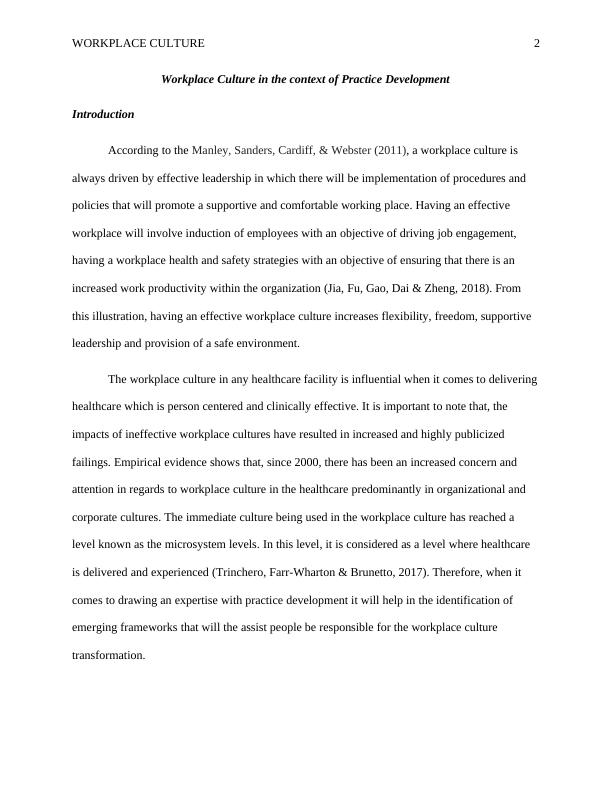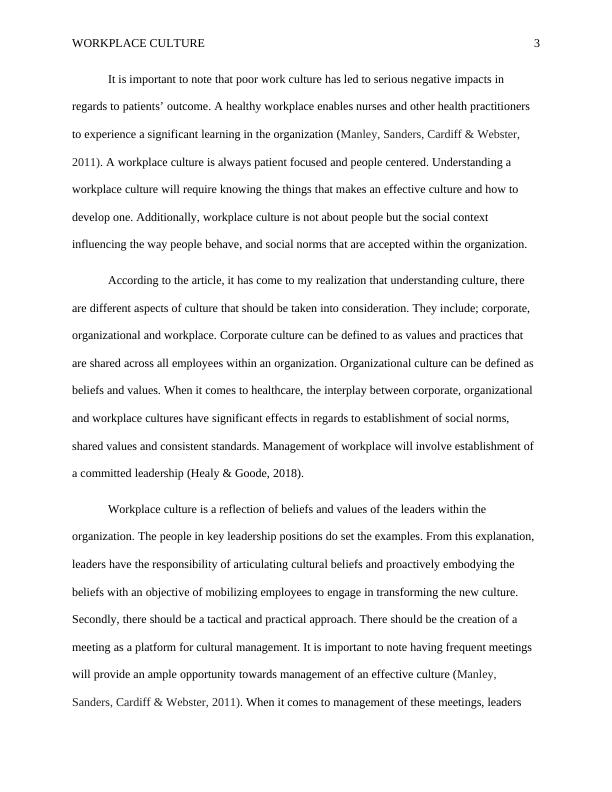Workplace Culture in the context of Practice Development
Added on 2023-06-03
13 Pages3747 Words312 Views
Running head: WORKPLACE CULTURE 1
Work place culture in the context of practice development
Student’s name
Institutional affiliation
Work place culture in the context of practice development
Student’s name
Institutional affiliation

WORKPLACE CULTURE 2
Workplace Culture in the context of Practice Development
Introduction
According to the Manley, Sanders, Cardiff, & Webster (2011), a workplace culture is
always driven by effective leadership in which there will be implementation of procedures and
policies that will promote a supportive and comfortable working place. Having an effective
workplace will involve induction of employees with an objective of driving job engagement,
having a workplace health and safety strategies with an objective of ensuring that there is an
increased work productivity within the organization (Jia, Fu, Gao, Dai & Zheng, 2018). From
this illustration, having an effective workplace culture increases flexibility, freedom, supportive
leadership and provision of a safe environment.
The workplace culture in any healthcare facility is influential when it comes to delivering
healthcare which is person centered and clinically effective. It is important to note that, the
impacts of ineffective workplace cultures have resulted in increased and highly publicized
failings. Empirical evidence shows that, since 2000, there has been an increased concern and
attention in regards to workplace culture in the healthcare predominantly in organizational and
corporate cultures. The immediate culture being used in the workplace culture has reached a
level known as the microsystem levels. In this level, it is considered as a level where healthcare
is delivered and experienced (Trinchero, Farr-Wharton & Brunetto, 2017). Therefore, when it
comes to drawing an expertise with practice development it will help in the identification of
emerging frameworks that will the assist people be responsible for the workplace culture
transformation.
Workplace Culture in the context of Practice Development
Introduction
According to the Manley, Sanders, Cardiff, & Webster (2011), a workplace culture is
always driven by effective leadership in which there will be implementation of procedures and
policies that will promote a supportive and comfortable working place. Having an effective
workplace will involve induction of employees with an objective of driving job engagement,
having a workplace health and safety strategies with an objective of ensuring that there is an
increased work productivity within the organization (Jia, Fu, Gao, Dai & Zheng, 2018). From
this illustration, having an effective workplace culture increases flexibility, freedom, supportive
leadership and provision of a safe environment.
The workplace culture in any healthcare facility is influential when it comes to delivering
healthcare which is person centered and clinically effective. It is important to note that, the
impacts of ineffective workplace cultures have resulted in increased and highly publicized
failings. Empirical evidence shows that, since 2000, there has been an increased concern and
attention in regards to workplace culture in the healthcare predominantly in organizational and
corporate cultures. The immediate culture being used in the workplace culture has reached a
level known as the microsystem levels. In this level, it is considered as a level where healthcare
is delivered and experienced (Trinchero, Farr-Wharton & Brunetto, 2017). Therefore, when it
comes to drawing an expertise with practice development it will help in the identification of
emerging frameworks that will the assist people be responsible for the workplace culture
transformation.

WORKPLACE CULTURE 3
It is important to note that poor work culture has led to serious negative impacts in
regards to patients’ outcome. A healthy workplace enables nurses and other health practitioners
to experience a significant learning in the organization (Manley, Sanders, Cardiff & Webster,
2011). A workplace culture is always patient focused and people centered. Understanding a
workplace culture will require knowing the things that makes an effective culture and how to
develop one. Additionally, workplace culture is not about people but the social context
influencing the way people behave, and social norms that are accepted within the organization.
According to the article, it has come to my realization that understanding culture, there
are different aspects of culture that should be taken into consideration. They include; corporate,
organizational and workplace. Corporate culture can be defined to as values and practices that
are shared across all employees within an organization. Organizational culture can be defined as
beliefs and values. When it comes to healthcare, the interplay between corporate, organizational
and workplace cultures have significant effects in regards to establishment of social norms,
shared values and consistent standards. Management of workplace will involve establishment of
a committed leadership (Healy & Goode, 2018).
Workplace culture is a reflection of beliefs and values of the leaders within the
organization. The people in key leadership positions do set the examples. From this explanation,
leaders have the responsibility of articulating cultural beliefs and proactively embodying the
beliefs with an objective of mobilizing employees to engage in transforming the new culture.
Secondly, there should be a tactical and practical approach. There should be the creation of a
meeting as a platform for cultural management. It is important to note having frequent meetings
will provide an ample opportunity towards management of an effective culture (Manley,
Sanders, Cardiff & Webster, 2011). When it comes to management of these meetings, leaders
It is important to note that poor work culture has led to serious negative impacts in
regards to patients’ outcome. A healthy workplace enables nurses and other health practitioners
to experience a significant learning in the organization (Manley, Sanders, Cardiff & Webster,
2011). A workplace culture is always patient focused and people centered. Understanding a
workplace culture will require knowing the things that makes an effective culture and how to
develop one. Additionally, workplace culture is not about people but the social context
influencing the way people behave, and social norms that are accepted within the organization.
According to the article, it has come to my realization that understanding culture, there
are different aspects of culture that should be taken into consideration. They include; corporate,
organizational and workplace. Corporate culture can be defined to as values and practices that
are shared across all employees within an organization. Organizational culture can be defined as
beliefs and values. When it comes to healthcare, the interplay between corporate, organizational
and workplace cultures have significant effects in regards to establishment of social norms,
shared values and consistent standards. Management of workplace will involve establishment of
a committed leadership (Healy & Goode, 2018).
Workplace culture is a reflection of beliefs and values of the leaders within the
organization. The people in key leadership positions do set the examples. From this explanation,
leaders have the responsibility of articulating cultural beliefs and proactively embodying the
beliefs with an objective of mobilizing employees to engage in transforming the new culture.
Secondly, there should be a tactical and practical approach. There should be the creation of a
meeting as a platform for cultural management. It is important to note having frequent meetings
will provide an ample opportunity towards management of an effective culture (Manley,
Sanders, Cardiff & Webster, 2011). When it comes to management of these meetings, leaders

WORKPLACE CULTURE 4
should be able to use story telling methods as a way of communicating to employees regarding
their job progress and personal progress (Mullane et al., 2018). This means that leaders will act
as a source of inspiration and increase accountability. Leaders should always recognize capable
employees and their specific contribution. Lastly, there should be leverage of cultural champions
for better outcomes.
The authors of the article have identified that workplace culture can manifest different
types of characteristics. Workplace culture shows the growth and upward dynamic that are
predominantly characterized by increased level of teamwork and employee engagement in
regards to the work that they do (Longman, Daniels, Bray & Liddell, 2018). Some of these
characteristics include:
Purpose driven workplace culture: successful organizations have a workplace culture
where employees have a clear sense of direction and purpose (Pidd et al., 2018). Additionally,
employees will also understand both immediate and long-term goals. This is an important
concept because having an organization with purpose helps in transforming people and collective
use of resources with an objective of achieving the set goals and objectives. It is important to
know that, purpose is a motivational driver when it comes to engaging employees and close
communities (Rees & Smith, 2017). This means that when a leader establishes purpose in an
organization, employees will be driven to accomplish these goals. As an illustration, purpose will
act as an engine of the organization. From this explanation, there is an existing relationship
between purpose and job performance. According to a survey conducted by Deloitte in 2004,
Deloitte discovered that organizations that are focused on purpose do inspire increased level of
confidence among its employees.
should be able to use story telling methods as a way of communicating to employees regarding
their job progress and personal progress (Mullane et al., 2018). This means that leaders will act
as a source of inspiration and increase accountability. Leaders should always recognize capable
employees and their specific contribution. Lastly, there should be leverage of cultural champions
for better outcomes.
The authors of the article have identified that workplace culture can manifest different
types of characteristics. Workplace culture shows the growth and upward dynamic that are
predominantly characterized by increased level of teamwork and employee engagement in
regards to the work that they do (Longman, Daniels, Bray & Liddell, 2018). Some of these
characteristics include:
Purpose driven workplace culture: successful organizations have a workplace culture
where employees have a clear sense of direction and purpose (Pidd et al., 2018). Additionally,
employees will also understand both immediate and long-term goals. This is an important
concept because having an organization with purpose helps in transforming people and collective
use of resources with an objective of achieving the set goals and objectives. It is important to
know that, purpose is a motivational driver when it comes to engaging employees and close
communities (Rees & Smith, 2017). This means that when a leader establishes purpose in an
organization, employees will be driven to accomplish these goals. As an illustration, purpose will
act as an engine of the organization. From this explanation, there is an existing relationship
between purpose and job performance. According to a survey conducted by Deloitte in 2004,
Deloitte discovered that organizations that are focused on purpose do inspire increased level of
confidence among its employees.

End of preview
Want to access all the pages? Upload your documents or become a member.
Related Documents
Importance of Workplace Culture in Practice Development in Healthcare Organizationslg...
|11
|3769
|493
Analysis of Effective Workplace Culture Framework 2022lg...
|11
|2686
|17
Effective Workplace Culturelg...
|11
|2634
|45
Effective Workplace Culture in Clinical Areaslg...
|12
|3208
|104
Leadership Style and Corporate Culture Connectionlg...
|4
|809
|152
Practice Development Tools for Practice Development Contents Introductionlg...
|17
|3607
|97
